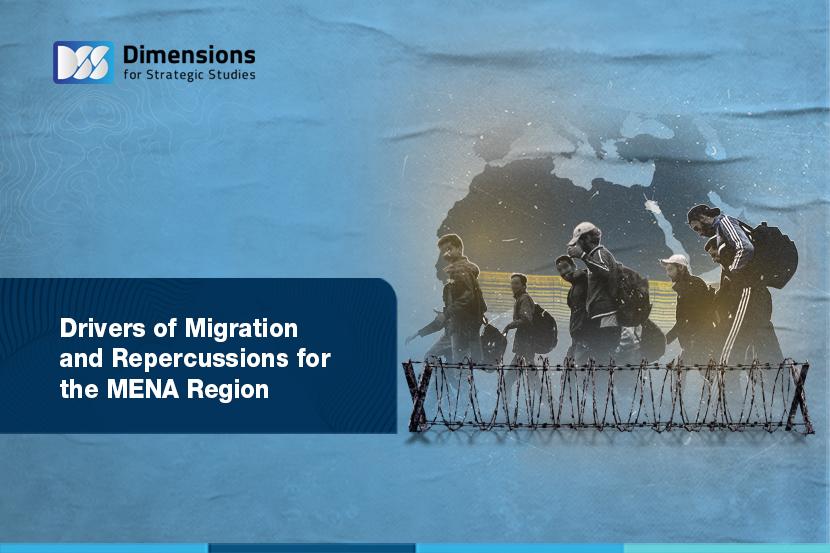
Drivers of Migration and Repercussions for the MENA Region
2024-07-175308 view
Introduction
The motives and drivers shaping trends of migration in the Middle East and North Africa region are themselves determined by regional and global dynamics. After a period of flexibility and fluidity which promoted the movement of people from the Global South to the developed North, there has been a shift to a system of ever-more coercive, preventative measures that have turned immigration into a heavy burden on receiving countries. This has been exacerbated by successive political and economic crises, escalating violence and armed conflicts, and the difficulty of controlling borders.
All this has prompted the Western world, where extreme right-wing movements are on the rise, to tighten the noose on clandestine as well as regular immigration, despite the vast contributions immigrants have made to building Western civilization. Extremists have called ever more loudly for measures to prevent these migratory movements, ignoring both the humanitarian and economic dimensions of migration. Western policies have turned to focus on preventing all forms of migration from the Global South.
North Africans make up the majority of migrants from the continent to Europe; the top three countries of origin—Morocco, Algeria and Tunisia—account for more than five million of the 11 million African migrants in Europe. This underscores the importance of geographic and cultural proximity, the presence of established immigrant communities, and economic opportunities as key pull factors in people’s decisions to migrate. [1]
Border closures due to the coronavirus pandemic left tens of thousands of migrants stranded across Africa, [2] where many have lost their jobs, homes and everything they own. Even since borders reopened, ongoing travel and health restrictions have affected the mobility of both regular and irregular migrants. [3] As making the crossing from Libya to Europe has become more difficult, prospective migrants have moved westwards in their attempts to reach Europe, attempting to do so via the straits between Morocco and the Canary Islands. [4] Migrants trying to leave Libya continue to face human rights violations and arbitrary detention.
This paper examines the key factors driving migration within the MENA region, along with the security, economic and social transformations that have directly fueled the exodus of people from countries of origin trapped in political and economic misery. It also examines the string of structural crises within countries of the region, and how they act simultaneously as both products and drivers of migration.
Conclusion
The dynamics of migration in the Middle East and North Africa, and its basic drivers, can be understood through a wide array of political, economic, security, cultural, value-based, social and psychological factors. This means that migration has extremely significant implications for countries across the MENA area.
There is no doubt that remittances sent home by diaspora citizens of countries in the region constitute an important economic resource for the budgets of these countries. Policies towards this category of immigrants need to be formulated with much more positivity, especially since future generations have been influenced by the culture of their host countries and stripped of their “original” identities. Development in migrant-sending countries also needs to be promoted much more effectively, according to well-formulated plans, allowing them to make use of their human potential and provide their citizens with more opportunities to invest in their homelands, rather than opting to migrate.
Migrants will face many future challenges, most prominently the dominance of security-based approaches, precautionary measures, border control, the fight against irregular migration, and the ongoing unrest across the region. Those hoping for a better life in Europe will swim against a tide of European policies that oppose immigration of all kinds, treat the southern bank of the Mediterranean as a source of chaos and disorder, and do everything possible to pressure the governments of the MENA region to control their borders and prevent irregular migration. These policies also make regular immigration much harder, driven by the rise of Western nationalists who reject all types of immigration, regular or irregular.
To read the full essay (in Arabic), click here .
resources:
[1] Africa Center for Strategic Studies, “Trends in African migration trends to watch in 2022,” January 21, 2022 (in Arabic), at, Link.
[2] Katharine Jones, Sanushka Mudaliar and Nicola Piper, “Locked down and in limbo: The global impact of COVID-19 on migrant worker rights and recruitment,” International Labour Organization, November 22, 2021, at, Link .
[3] International Organization for Migration, “World Migration Report 2022, Link.
[4] Mixed Migration Center, “Mixed Migration Review 2021,” November 30, 2021, at, Link.





